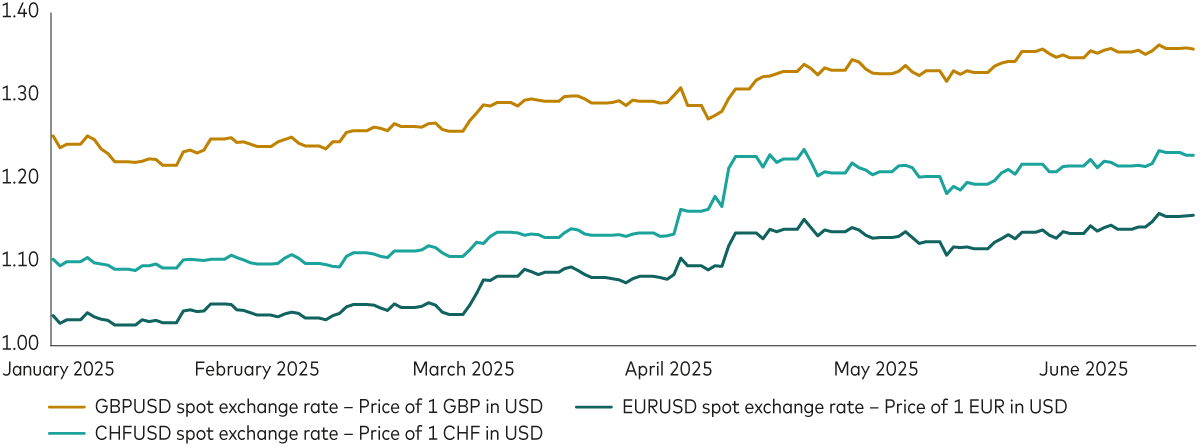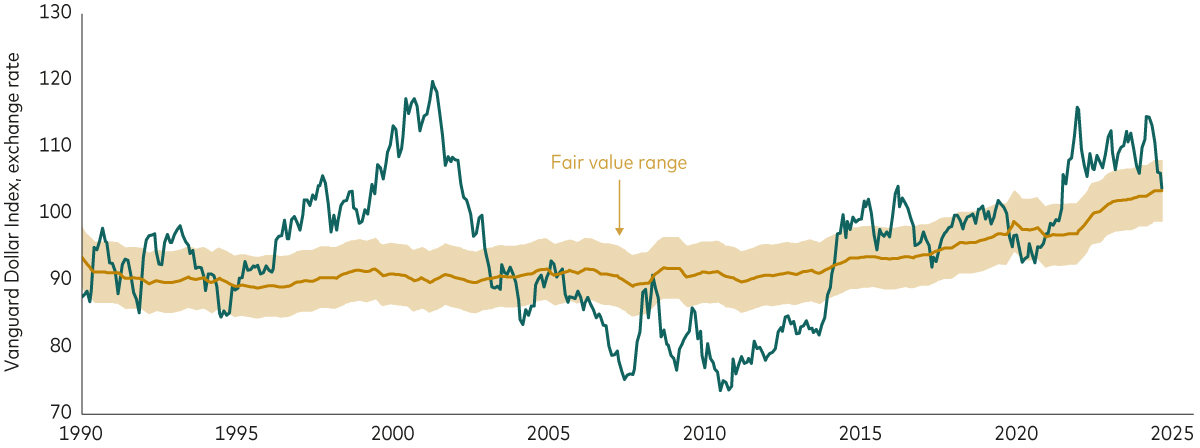In 2025, headlines have been dominated by the weakening of the US dollar. Yet, beneath the surface of short-term fluctuations lies a more enduring truth: the US dollar remains the most-used currency in the global financial system 1. While recent depreciation has implications for investors, that does not necessarily imply that the US dollar is weak.
A weakening US dollar does not equal a weak US dollar
The recent slide in the US dollar’s value—around 10% year-to-date versus sterling 1—has been driven by a mix of economic cooling, geopolitical uncertainty and the April 2025 announcement of new US trade tariffs (see the first chart below). Historically, such uncertainty has typically led to a strengthening of the US dollar as investors sought safe-haven assets. But this time, the US dollar has experienced a pronounced decline, reflecting a shift in investor sentiment and its valuation.
However, a weakening US dollar doesn’t equate to a weak US dollar. In fact, the US dollar has returned to its fair value range for the first time since 2021, according to Vanguard’s valuation models (as the second chart below shows). This suggests that the currency is no longer overvalued relative to its economic fundamentals, such as productivity and real interest-rate differentials, and against a basket of other major currencies.
The US dollar has weakened against major currencies in 2025

Past performance is not a reliable indicator of future returns.
Source: Bloomberg and Vanguard calculations, chart data as at 17 June 2025.
The dollar returns to fair value for the first time since 2021

Past performance is not a reliable indicator of future returns.
Notes: The chart shows our fair-value estimate for the US dollar against an equity market capitalisation-weighted basket of the euro, the Japanese yen, the British pound, the Canadian dollar and the Australian dollar. The fair-value estimate is based on the part of exchange-rate movements that can be explained through differentials in relative economic strength, measured by productivity (GDP per capita at purchasing power parity) and long-term real rates.
Source: Chart based on data from Refinitiv and the International Monetary Fund, as at 9 July 2025.
Implications for investors
For investors, especially those based in the UK, the US dollar’s depreciation has real consequences. Over the past decade, a strong US dollar and booming US equity market have boosted returns for unhedged UK investors. But with the dollar now fairly valued and US equity valuations looking stretched, future US equity returns may be more muted for sterling-based investors.
This has reignited interest in currency hedging. Yet, as Vanguard’s research cautions 2 , hedging is not a panacea. While hedging may reduce short-term volatility, it can be costly over time and often fails to deliver consistent benefits. With the US dollar now within its fair value range, the cost of hedging has come more into focus. As such, we encourage investors with a long-term horizon and wealth accumulation or preservation goals to hold global equities unhedged and global bonds hedged. This is to capture as much of the diversification benefit as possible of both the underlying assets and currency fluctuations, while ensuring that volatility is consistent with the comparable local asset. Overall portfolio volatility can be reduced by maintaining a balanced and diversified portfolio across and within asset classes.
The US dollar’s unrivalled share of global markets
Despite recent depreciation, the US dollar remains the most-used currency in global markets. For instance, the US dollar represents 58% of global foreign exchange reserves, 64% of international debt, 51% of international loans and 50% of global payments 3. These figures dwarf those of other major currencies as a portion of the global finance and investing landscape.
Fundamentals over headlines
While the US dollar’s recent decline has sparked debate, the fundamentals remain clear. The US dollar is undergoing a cyclical adjustment. Investors should look beyond short-term movements and focus on long-term positioning. A diversified global portfolio, with unhedged global equities and hedged global bonds, remains one of the best ways to navigate an evolving world in which the US dollar still plays a major role.
The benefits of global diversification – staying the course with a multi-asset solution
Considering the recent US dollar weakness, it’s crucial for investors to maintain a balanced and diversified portfolio. Naturally, when the US dollar depreciates, other currencies appreciate. Diversifying across asset classes (equities and bonds) and within asset classes (styles, sectors and countries) can help reduce overall portfolio volatility.
While currency fluctuations are a natural part of the global economic cycle, a broadly diversified investment strategy can help mitigate these risks and still capitalise on the opportunity for long-term growth.
1 Source: Vanguard and Bank of England. The £/$ exchange rate was $1.25 as at 31 December 2024 and $1.37 as at 30 June 2025.
2 What the decline of the US dollar means for investors - Lukas Brandl-Cheng, Investment Strategist Analyst, Vanguard Europe and Ian Kresnak, Investment Strategist Analyst, Vanguard US.
3 Note: FX reserves refer to foreign currency assets held by central banks to support monetary policy and currency stability. International debt includes bonds issued by a country’s residents in foreign markets or currencies. International loans are cross-border lending arrangements between institutions or governments. SWIFT (Society for Worldwide Interbank Financial Telecommunication) tracks global financial messaging flows, often used as a proxy for currency usage in international payments. Source: Bloomberg Intelligence, ECB, IMF COFER, SWIFT, BIS. Data as at April 2025 (SWIFT), Q4 2024 (Reserves), Q4 2023 (Debt & Loan) as at June 2025.
Related funds
Build your knowledge and earn CPD
Discover tools, guides and multimedia resources. Built for (and with) financial advisers.
Events and webinars
Explore upcoming events and our on-demand library. All CPD accredited.
Investment risk information
The value of investments, and the income from them, may fall or rise and investors may get back less than they invested.
Important information
This is directed at professional investors and should not be distributed to, or relied upon by retail investors.
This is designed for use by, and is directed only at persons resident in the UK.
The information contained herein is not to be regarded as an offer to buy or sell or the solicitation of any offer to buy or sell securities in any jurisdiction where such an offer or solicitation is against the law, or to anyone to whom it is unlawful to make such an offe\r or solicitation, or if the person making the offer or solicitation is not qualified to do so. The information does not constitute legal, tax, or investment advice. You must not, therefore, rely on it when making any investment decisions.
The information contained herein is for educational purposes only and is not a recommendation or solicitation to buy or sell investments.
Issued by Vanguard Asset Management Limited, which is authorised and regulated in the UK by the Financial Conduct Authority.
© 2025 Vanguard Asset Management Limited. All rights reserved.
